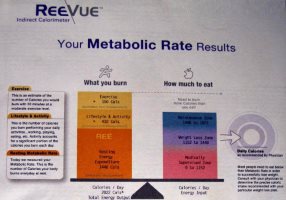Basal Metabolic Rate (BMR) refers the caloric intake the human body require to maintain existence at rest. This provides a basis for identifying the number of calories one can target to lose, maintain, or gain weight. This article from Rebecca MacLary describes the process and formulas to follow for weight loss.
Determine Your Daily Caloric Needs to Lose Weight Safely and Effectively
One thing that makes people fail at weight loss, or healthy weight maintenance, is the fact that they don’t know how many calories they need to consume on a daily basis. People either eat too many calories, or too few. This article will explain how to calculate your daily caloric needs.
In order to determine your body’s daily caloric needs, you need to know your Basal Metabolic Rate (BMR). Basal Metabolic Rate is the basic amount of energy required to power your body while at rest. The BMR formula takes your height, weight, gender, and age into consideration. Once you know your Basal Metabolic Rate, you may plug it into another equation called the Harris Benedict formula and determine your daily caloric needs.
The Harris Benedict formula does not take into consideration: if the person is extremely lean (will underestimate the number of calories required); extremely low in muscle mass (will overestimate the number of calories required); or if the person is nursing mother. If you are a nursing mother, add between 300 and 500 calories to the number you determine is your BMR (because you have a higher basic caloric requirement).
To determine your Basal Metabolic Rate, use this formula (source: bmi-calculator.net):
**calculate the amounts inside the brackets first
Women: BMR = 655 + (4.35 x weight in pounds) + (4.7 x height in inches) – (4.7 x age in years)
Men: BMR = 66 + (6.23 x weight in pounds) + (12.7 x height in inches) – (6.8 x age in years)
Now you know your Basal Metabolic Rate – the base amount of calories daily that your body needs just to maintain while at rest. To determine how many calories your body needs to go about your day (work, exercise, and play), you must next determine your level of activity: sedentary, lightly active, moderately active, very active, or extra active. Your level of activity will change the amount of calories you should consume each day for proper weight loss or maintenance.
If you are sedentary, you do little or no exercise each day. You might call yourself a “couch potato.” Light activity means you exercise or play sports one to three times a week. Moderate activity means you perform moderate exercise or play a sport three to five times a week. If you are very active, you exercise hard or play a sport six to seven days a week. If you are extra active, you have a very active job and exercise daily, or you train for a sport or activity twice a day, seven days a week.
Once you have determined your level of activity, you may use the Harris Benedict Equation combined with the results of your BMR calculation. (source: bmi-calculator.net)
Sedentary: Calorie Requirement = BMR x 1.2
Lightly Active: Calorie Requirement = BMR x 1.375
Moderately Active: Calorie Requirement = BMR x 1.55
Very Active: Calorie Requirement = BMR x 1.725
Extra Active: Calorie Requirement = BMR x 1.9
The result is of this formula is the number of calories your body daily needs to maintain its current weight. For example, say you have a BMR of 1397.7 (32 year old female who is five feet, six inches tall) and are moderately active. Caloric Requirement = (1397.7) x 1.55. Caloric Requirement is 2166 calories per day for weight maintenance.
The safest way to lose weight is to subtract between 500 and 1000 calories from the amount needed on a daily basis. Never impose a deficit of more than 1000 calories per day – that is an unsafe practice and can be detrimental to health. In addition, it will put your body into “starvation mode” and you will not lose weight.
Using the example from above, the 32 year old female who is five feet, six inches tall and moderately active would consume between 1166 calories and 1666 each day for a safe rate of weight loss. At this rate you will see a loss of about one to two pounds per week, which is the optimal rate for safe weight loss. The slower you lose the weight, the more likely you will keep it off, in the end.
With a small amount of math, it is easy to determine how many calories your body needs each day for weight maintenance or loss. Follow the guidelines shown above for safe weight loss. Once you reach your desired weight, increase your caloric intake back to the suggested amount for maintenance.
